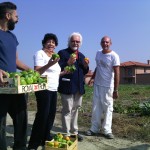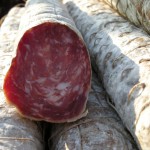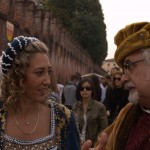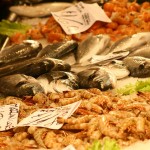A special kind of peppers that you can taste in Oltrepò Pavese
Pagani, the Madonna of the hens
A traditional Easter celebration in Southern Italy
A really particular event takes place in Pagani during the Easter period: the so called Madonna of hens (Madonna delle galline, in Italian).
The event lasts one day and every family sets in his yard a little aisle to the Madonna, the “toselli”, they are the symbol of maternity and the entrance, looking like a womb.
Legends say that a paint of the Madonna was found by some hens, at some point. Result is the tradition of every family giving a hen to the church for a while, as a symbolic gift.
During the celebrations, some food tasting time too: try some typical artichocke filled with oil, garlic and parsley, grilled on the charcoal.
With the contribution of: Regione Campania, Unione Europea – POC Campania 2014-2020 & Fondazione Film Commission Regione Campania
Video full text: Madonna of the hens (Part 1)
A tiny cup of coffee – on the terrace of the highest hotel in Naples.
This morning from Naples we’re off to the nearby town of Pagani,
where, at Easter time, there is a particular type of festival.
Zoe, who studies anthropology, wants to see it.
It’s the festival of the Madonna of the hens!
It’s late… let’s go! The Madonna and the hens are waiting for us.
The hens? It must be a hen house!The party has already begun.
We’re on the road heading for Pagani.
Come on, we’re late, it’s already passed through.
Has the procession already passed? Yes, at 9 am.
It’s finished! The Madonna has already been out – of course not, it’s not over!
I have done my research, the festival goes on, the Madonna returns at one in the morning.
It finishes tomorrow morning, and goes on all day.
How do you know that?
I have done my research, the anthropologists in this area have excelled themselves.
So, where are we going now?
I’m taking you to the toselli, the courtyards where they prepare… but I’m telling you nothing.
You have to see it for yourself!Every family has set up a small altar to the Madonna in their own courtyard.
Here they call it a tosello, in the Spanish way.
Like this one? Is this a tosello?It’s a small altar.
Certainly. It’s the symbol of the maternal.
It resembles a womb, a uterus! A gut.
You enter and down there is this altar that is in fact a cavern.
With the Madonna and the hens, beautiful!
A sense of the divine that is absolutely female.
I understand, you’ve brought me to Naples to see the womanly Naples.
This place is also called Pagani, what more is there to say!
The sentiment is that of a Madonna – that is a woman, a divine creator.
To whom we continue to pay attention, and love.
Because it is the bosom and everything there that is positive.
It’s not war, it’s not aggressiveness, it’s the opposite – it’s life!Neapolitan songs
“Beautiful young lady, what’s your name? – Beautiful young lady, what’s your name? – My name is sana core, what do you want.
Can you translate it for me? You neither, right?
I’ve got it, we have to learn the dance.
You always have to move, turning like this.
She has to learn, doesn’t she?
Madonna of the hens (Part 2)
My daughter Zoe and I are in Pagani,
a town not far from Naples where a traditional Easter-time festival is under way.
It’s the festival of the Madonna of the hens.
A particular feature of the festival is that the inhabitants of Pagani arrange small altars or toselli in the courtyards of their homes.This is a tosello, an actual arrangement set up by the family.
Have you seen the symbols? The artichoke, today is the day of the artichoke,
then the birds, the hens, the dove… a veritable hen house.
This deeply felt tradition continues.
We wait for it all year!
We are at the so-called African tosello, the historical one,
that inspired the great musical opera “Gatta Cenerentola” by De Simone.Neapolitan songs
The famous artichokes! On the charcoal, do you put anything in them?
Garlic and parsley.
Just how I make them, with oil, garlic and parsley,
and then they’re burnt.
That’s true!What do I have to do here? Like this, but faster!
There are seven Madonnas: the Madonna of Mount Carmel, the Black Madonna,
the Madonna of the Hens, of Grace and of the Arch.
The Madonna of the Virgin World.
A bit like the seven dwarfs, one is always forgotten.
The extraordinary thing is the preservation of an act of faith that remains and persists.
They tell me that the best part of the festival begins now!
That is the painting of the Madonna that was found by the chickens that were scratching about.
The hen house was in that area, let’s go an take a look.
The first building is this, where we find the hens that are donated by the faithful.
Donated? So the Church keeps them all?
It keeps them for a short time, today the procession has begun.
They’re on loan, from tomorrow the redemption begins.
Everyone returns to collect their hen, donating money in return.
They recognise them by their bow.
Let’s go to the Aunt, the woman who offers food to everyone!The mothers! That appease the hunger!
Let’s raise a glass to Signora Rita and her friends.
They organise this spread every year in honour of the Madonna.
A toast to Signora Rita!Neapolitan song
Thank you!
So, how is it? Did you like it?
You have created a monster, me! I feel totally at ease.
It’s wonderful, there is so much care.
It’s not confusion as an end unto itself, it’s orderly, educated.
One thing at a time, that grabs you and includes you.
It resembles the Seville Fair, there are people dancing everywhere.
But all things considered, it’s orderly. It’s not a freak out, but scientific entertainment.
At the risk of repeating oneself, the value of this event,
just like all the other Marian events,
is undoubtedly faith, but above all the preservation of an ancient tradition.
An ancient ritual that evokes the most ancient and archaic Goddesses.
Right up to the primordial goddesses, like the Mater Matuta!
Our journey began in Capua, where we went to see the Mater Matuta,
and ended here in Pagani, where we have seen the Madonna of the hens.
There is meaning.
Generally speaking if you come you’ll have fun and you’ll eat like crazy!
And then there are the tammurriate (traditional songs and dance with tambourines)!
Visit Naples: helpful hints
Italian name: Napoli
Arrival
Naples has its own international airport, connected to the city centre by a bus (it takes 15 minutes and it costs 5€). For transcontinental flights you have to stop in other airports, Rome is the closest one.
Transports
In Naples you find both buses, subways and funicular. The ticket is the same for all the transports and it costs 1,5€. For more information check the ANM website. If you prefer to visit the city on foot, here you can find an idea for you tour.
What to do
Naples is the capital city of Campania region, in Southern Italy. Naples is on a beautiful Gulf, extended from the Sorrento Peninsula to the volcaninc area called Phlegrean Fields, on the background the huge Vesuvius, one of the two active volcanoes in Italy. In the Gulf, three famous islands – Capri, Ischia and Procida. The historical centre of Naples is listed as a UNESCO World Heritage Site since 1995, the most important monuments are the Dome, Palazzo Reale and the Maschio Angioino.
Speaking of food, Naples is the city where Pizza is born!
Where to sleep
The best place to sleep in Naples is of course the city centre. Other very good alternatives are Posilippo and Vomero area, the harbor and the University area, the boardwalk and the more expensive Chiaia area.














